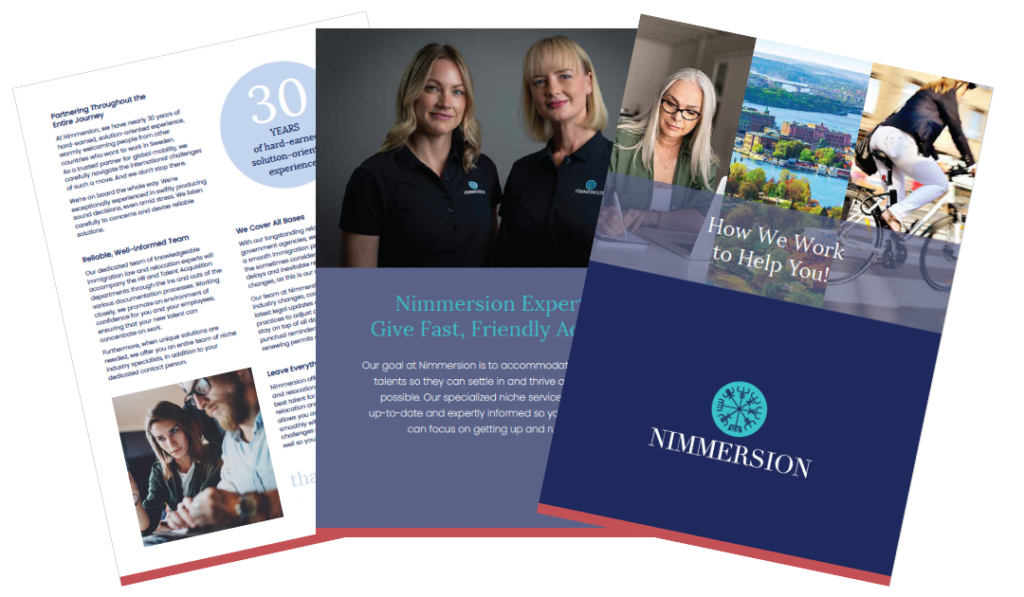 If you are an HR professional and new to global mobility, you will find that your learning curve needs to be steep when bringing new hires to Sweden to fill skills gaps. Before you engage a relocation firm, for all or parts of the chores ahead, we recommend that you ask yourself these 5 questions.
If you are an HR professional and new to global mobility, you will find that your learning curve needs to be steep when bringing new hires to Sweden to fill skills gaps. Before you engage a relocation firm, for all or parts of the chores ahead, we recommend that you ask yourself these 5 questions.
What are your inhouse capabilities?
Is global mobility part of your role already, or is a talent skills gap driving the need to find talent abroad quickly? Do you work at a company with a compensation and benefits department, salary department, an HR department running alongside a team of recruiters?
If you have a local team on standby to welcome talent, then you will need certain things covered to be successful. If all the responsibility for holding this expertise falls on just a few people, this will determine what level of support you will need to manage a great welcoming of talent from abroad.
Companies with departments full of experts are likely to want hands-on practical assistance with securing housing, schooling and local registrations. At the same time, companies that are fairly new to recruiting talent abroad and dividing up the tasks between only a few people probably also need policy and task guidance. In that case it makes sense to engage a firm to be responsible for the compliance and oversee the entire relocation so you can focus on the more strategic aspects in your own role within the company.
How much time do you have to fill your skills gaps?
Even experts in local global mobility can expect 30-40 hours to settle a junior colleague in a new location and about twice that for an executive with a family. Helping someone settle in a new location may be difficult and time consuming, however it is very rewarding for those that have the time.
Take stock of how much time you have and engage an expert firm accordingly. If you have spare time and the global mobility activities are part of your job description then there are certainly portions of the settling in that can be handled in-house.
Taking care of talent from abroad isn’t only administrative, it’s also a chance to be an ambassador for your country and city. Seeing your everyday taxes, school system, government authorities from an outside view is interesting and also sharing history and everyday life with a new colleague is fun. You will read the newspapers in an entirely new way when you are constantly thinking of how to include it in your introduction to new staff in your office.
What are your company’s resources?
Are you already working in an HR database and information-system that has data on immigration, salary, taxes, and data from previous transfers of talent? If you are, then you have some very useful resources at your fingertips. While rental levels are ever changing, if you have welcomed talent in the last quarter you should have a fair idea of price levels to the point of being able to guide your new colleague.
Housing is difficult in most Swedish locations. Having a database of available properties is essential and if your company collects such data you can utilise it for your staff members. If you are also sending staff members to other locations you may be able to connect inbound and outbound employees essentially killing two birds with one stone. Do remember to keep the work environment free from friction between staff members though, so do get involved with the inspection protocols, lease processing and rental level negotiations. You can read more about that here
Having a tax consultancy firm or inhouse compensation and benefit experts will greatly help when bringing in talent.
If you don’t have access to resources to help you, a relocation services firm will considerably alleviate your burden. Not only can they assist in most matters, they know what needs to be done both in-house and by external experts so you don’t miss anything.
How many moves do you handle per year?
Of course, the numbers of new talent coming into your office and location will determine what kind of support you may want to seek from outside counsel.
If you have one or two people per year and a limited budget you will be able to set aside time to fill in the blanks for them and also accompany them to the authorities, etc. The more complex moves are the executives moving with families. You can expect them to move July/August to be ready when school starts in August. If your new hire has kids in school give yourself at least 6 months to plan. Relocation firms are open across the year and if you are looking to solve some admin matters yourself, make sure it doesn’t coincide with your vacation.
If you have more moves than a couple per year your time is likely to be a factor and you may have difficulties to manage to do it all unless it is your primary job duty. We see HRs that often work almost around the clock and most certainly on weekends when they have talent coming in from abroad. This can definitely be the answer for a short while, but for a more long term solution either a new staff member needs to be recruited and trained to support you, or an outside counsel be brought in when needed.
Some companies have volumes of moves from time to time. It often coincides with a local project, often IT implementations or product launches. The immigration can become very urgent and a bunch of people may need a warm welcome during a short period of time. If your recruitment team has been very busy finding talents that are both a task and a cultural fit with your organisation, you may be left with all of the details around giving new employees all they need to be welcomed to your company and to Sweden.
The advantages of a number of moves at the same time is that the knowledge you gain and the jurisdiction you brush up on will be used multiple times. Tax tends to be very individual and can’t be put into a cookie-cutter, but immigration matters are more streamlined and there is scalability in the knowledge base.
The challenge is of course tailoring the support to each individual’s needs. Usually when a number of people are moving around the same time there is either time or budget allotted for the aftercare that comes after the recruitment phase is finished.
Again, depending on the resources in-house, different levels of support is needed from handholding to strategic and policy level facilitation.
What are the needs of the new hires you are recruiting?
If you have an expat talent population of young engineers who are rotating between locations their needs will be very different from the permanent hires or executives with families planning to stay 3-5 years. The programs and services you offer in your policy, should reflect who you are recruiting.Relocation companies will be able to help you evaluate the level of support needed for each type of recruit.
We hope some of these tips are helpful. For further reading, this blog post might be helpful:
9 Ways to Work With Most Effectively With Your Swedish Relocation Company
For more useful resources you may wish to download our Global Mobility Policy Handbook.
Read more about how we work with relocation and Immigration services

Discover how Nimmersion can streamline the relocation and immigration process for your global talent, ensuring a seamless transition and swift integration into Sweden. Our nearly 30 years of experience and dedicated team provide fast, friendly, and reliable support.

